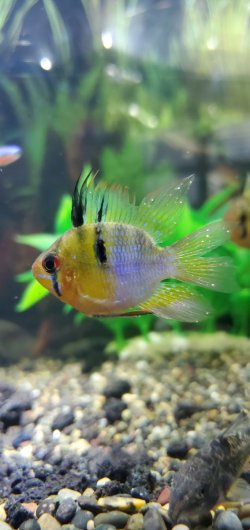Jennifer Deleon
New Member
- Joined
- Jul 14, 2019
- Messages
- 5
- Reaction score
- 2
Help my fish are riddled with white spots!
I just recently got into owning fish and I was unaware about cycling. So 2 days later after tank set up I stocked my tank. I know its cruel and I feel bad already i also didn't know that each required different needs. I am going on 2 weeks now in the cycling process
Fish: 8 Cardinal tetras, 3 cories, 3 platies, 2 mollies, 3 balloon German rams
Tank size is 20 g. Long
Parameters# 7.6 ph, ammonia .50 pom, nitrite .25ppm, nitrate 10ppm. I've done 25% water changes everyday. Put a pinch of seachem safe, and some bio booster. Water temp. Is 78-79
How i am trying to speed up cycling: bio booster, 1 amazon sword, 1 cryptacorne, water lettuce, seaweed looking moss, and 4 java ferns. Stuff i got from a established tank and transferred to mine. A cup of water, a cup of gravel, tank. And drift wood. I also put a bubbler to displace any gases, and my filter unfortunately is pretty new (2wks).
And as I looked at my older pics of my fish I realized that my rams had already white spots since i got them. And I thought that was normal. But now there's more and my tetras and platies are starting to show now. Also one of my platies hot the shimmies. I think it may be be ICH or lymphocystis for the white spots i don't know about the shimmies though. But if it's one or the other how do I treat without harming the rest. And I can't return the fish because they know I got a new tank and will blame me. so any help will be helpful
so any help will be helpful





I just recently got into owning fish and I was unaware about cycling. So 2 days later after tank set up I stocked my tank. I know its cruel and I feel bad already i also didn't know that each required different needs. I am going on 2 weeks now in the cycling process
Fish: 8 Cardinal tetras, 3 cories, 3 platies, 2 mollies, 3 balloon German rams
Tank size is 20 g. Long
Parameters# 7.6 ph, ammonia .50 pom, nitrite .25ppm, nitrate 10ppm. I've done 25% water changes everyday. Put a pinch of seachem safe, and some bio booster. Water temp. Is 78-79
How i am trying to speed up cycling: bio booster, 1 amazon sword, 1 cryptacorne, water lettuce, seaweed looking moss, and 4 java ferns. Stuff i got from a established tank and transferred to mine. A cup of water, a cup of gravel, tank. And drift wood. I also put a bubbler to displace any gases, and my filter unfortunately is pretty new (2wks).
And as I looked at my older pics of my fish I realized that my rams had already white spots since i got them. And I thought that was normal. But now there's more and my tetras and platies are starting to show now. Also one of my platies hot the shimmies. I think it may be be ICH or lymphocystis for the white spots i don't know about the shimmies though. But if it's one or the other how do I treat without harming the rest. And I can't return the fish because they know I got a new tank and will blame me.
 so any help will be helpful
so any help will be helpful



